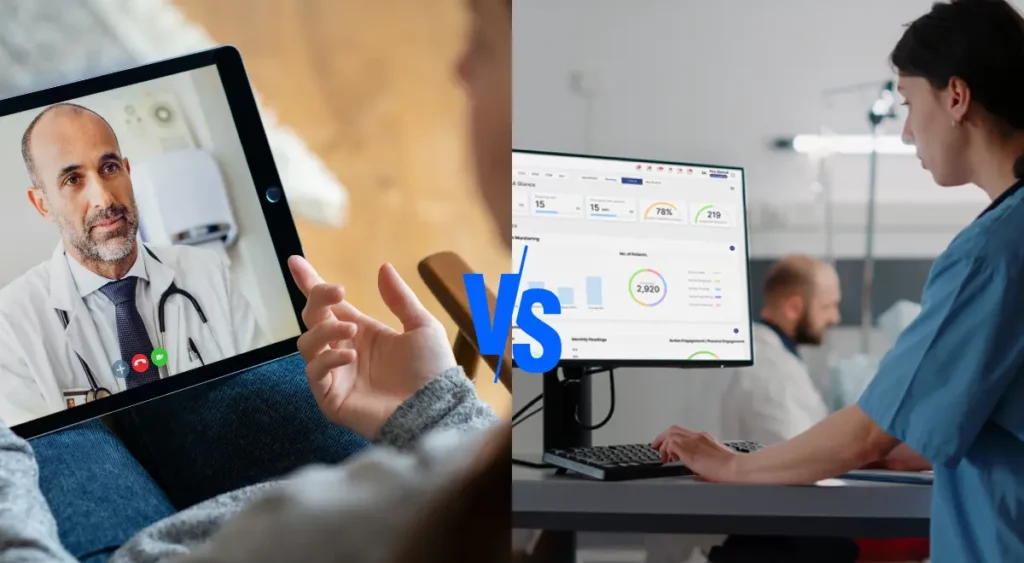HealthArc Platform vs RPM Software Solutions

Is your healthcare organization trying to pick a remote patient monitoring solution?
It’s a tough choice. You have to decide between a fully managed platform like HealthArc or a software-only solution that your own team will have to manage.
Getting this right is key. The right choice helps you care for patients better, makes your staff’s job easier, and ensures you get properly paid.
Our goal is to give you a clear way to decide what works best for your team, your goals, and your patients.
Table of Contents
ToggleHealthArc Platform Deep Dive
Choosing a remote patient monitoring platform is a big decision. HealthArc is a fully integrated option that handles the entire process for you, unlike software-only systems that require more work from your own team.
Think of it as a complete package. It includes cellular connected medical devices, easy to use software, and a dedicated clinical team to support you. This end-to-end approach is built to make remote care actually work.
Devices & Patient Engagement
The system works with over 40 different FDA approved health devices, like blood pressure cuffs and glucose monitors. A key advantage is that many devices use cellular networks. This means no confusing setup for patients. There is no Wi-Fi to connect, no Bluetooth to pair with, and no apps to download. Patients just use the device, and their readings are sent automatically. This simplicity leads to much higher patient participation.
AI-Driven Clinical Pathways & Communication
The software is designed to make your team’s job easier. Its AI-driven clinical pathways can be customized to your needs. This helps your clinicians quickly spot patients who are at high risk or who are not sticking to their plan, so you can help them at the right time. The platform also lets you communicate with patients through text, phone, or email, however they prefer.
Billing & Compliance Automation
HealthArc also manages all the complex billing for you. It automatically handles the documentation and claims for every major program, including RPM, CCM, and RTM. This removes a huge administrative burden.
Dedicated Clinical Support Staff
Perhaps the biggest difference is the people behind the platform. You are not on your own. HealthArc provides a dedicated pod of support staff. This includes enrollment specialists, nurses, and medical assistants who handle patient onboarding, follow-up calls, and daily monitoring. This lets your organization offer top-notch remote care without overloading your existing staff.
This model is proven. Over 750 provider groups across more than 40 states are using HealthArc to monitor more than 65,000 patients with chronic conditions.
In short, HealthArc is for providers who are done with complicated, piecemeal solutions. It brings together reliable technology, expert support, and a focus on the patient experience to deliver real results without the operational headache. If you want a complete program that helps patients and empowers your staff, HealthArc is a strong choice.
HealthArc is built for healthcare organizations ready to move beyond patchwork solutions. By combining cutting-edge technology, integrated devices, and real clinical support, it delivers results—both in patient outcomes and operational simplicity.
Comparing Leading Remote Patient Monitoring (RPM) Software Platforms
There are a lot of remote patient monitoring software options out there for healthcare providers. But it’s important to know they’re not all the same.
Many of them are just software tools. They give you the program, but your own team has to do all the work to run it. Let’s take a look at four of the top options that take this software-focused approach: Prevounce, ChronicCareIQ, Nsight Health, and TimeDoc.
1. Prevounce
Prevounce was started in 2018. They built a flexible platform that focuses on both the technology and the people using it. Their software helps providers run remote patient monitoring, chronic care, and annual wellness programs all from one place. A key feature is their support for specific cellular devices that don’t need Wi-Fi, like their own Pylo blood pressure monitors and scales.
You can set up automatic reminders and messages for patients via text or email to help them stay on track. The software shows patient data in clear charts and trends, so your clinical staff can quickly understand a patient’s status. It also connects with major EHR systems to make workflows easier and to help with billing.
Prevounce is flexible. You can use just the software for your own staff, or you can pay for their extra services to help run the program. This makes them a good fit for different types of organizations, from small practices to larger health systems.
2. ChronicCareIQ
ChronicCareIQ is a platform built to fit into how you already work. The company started in 2014 with a simple goal: to help clinicians and patients stay connected between appointments using the tools they already have. It brings together patient data, daily clinical tasks, and billing into one system that works with your current setup.
A standout feature is its smart patient surveys and a simple, color-coded dashboard. Your team can see a patient’s status instantly. A red, yellow, and green alert system quickly shows which patients need urgent help. It’s also very accessible. Patients can use their smartphones, a web browser, or even simple text messages, which makes it easier for them to stay involved.
The platform automatically tracks time spent on patient care. This creates the documentation you need for straightforward, audit-proof billing. A major advantage is that it works with almost any device. Your patients can use what they already own, so you avoid being forced into one specific device.
It’s used by everyone from primary care doctors to specialists in cardiology and neurology. They report a strong 87 percent of patients stay engaged with the program for over a year. This really shows the platform is easy to use and effective in practice.
4. Nsight Health
Nsight Health provides more than just software. It combines smart technology with a clinical support team that is available all day, every day. Their platform uses AI to handle routine tasks, automatically flag the most urgent patients, and get them help quickly. It connects with over 50 different EMR systems, so it fits right into your existing workflow.
The real key is their people. A team of clinicians is available 24 hours a day to educate patients, monitor their data, and escalate care when needed. They also offer a white label service. This lets a hospital or health plan put their own brand on the program and tailor it for their patients.
They also provide cellular enabled devices like glucose meters, pulse oximeters, and ECG monitors that work right out of the box. This full package of tech and support gets results. For instance, they have seen a 10 percent improvement in blood pressure control for their patients in just a few months.
They work with many types of organizations, from hospitals and insurance companies to employers, showing they can handle large, complex programs.
5. TimeDoc
TimeDoc’s software connects directly to major EHR systems like Allscripts, Athenahealth, and NextGen. This makes it a natural part of your clinical workflow. They offer flexibility. You can use just the software, use their staff to help run your program, or let them manage the entire remote care service for you.
A key feature is their focus on both behavioral health and chronic care. This makes the platform useful for more than just traditional remote monitoring. Their cellular enabled devices, like blood pressure cuffs and scales, send data automatically using LTE. Patients do not have to set anything up.
The software sends data straight into patient charts, automates documentation, and lets you set custom alerts for your entire program or for a single patient. The company uses evidence based protocols to make workflows more efficient and to improve patient outcomes.
Over 100,000 patients served and a model amounting to an estimated $167 reimbursement per patient per month, TimeDoc is a trusted partner when it comes to scaling practices without adding to the clinical burden of its practitioners. TimeDoc’s 2022 Series B funding has also fostered technology improvement and growth around scalability, notably within community health centers and federally qualified health clinics.
Head-to-Head Comparative Analysis: Choosing the Right RPM Solution
Choosing the right remote monitoring system means understanding a key difference. Some companies handle everything for you, while others just give you the software to run yourself. Let’s compare HealthArc to other leading software options. We will look at four important areas: how they operate, the clinical support they provide, how their technology works, and the cost.
| Feature | HealthArc | Prevounce | ChronicCareIQ | Nsight Health | TimeDoc |
|---|---|---|---|---|---|
| Clinical Staff | Included | Optional (extra cost) | Your staff | 24/7 clinical team | Flexible |
| Devices | 40+ FDA cellular | Pylo devices | Any device | 50+ devices | LTE cellular devices |
| Billing | Automated (RPM, CCM, RTM) | EHR + manual | Automated time logs | EMR integrated | Direct-to-EHR |
| Scalability | Vendor-managed | Staff-dependent | Staff-dependent | Hybrid | Flexible |
| Implementation | Quick launch | Longer setup | Longer setup | Moderate | Flexible |
Operational Model & Implementation
HealthArc is a complete, fully managed service. It handles everything. This includes providing devices, signing patients up, and having their own clinical team do the monitoring. It is for organizations that want a ready-to-use program. Their software also automates complicated tasks like billing for different services, which cuts down on paperwork for your staff.
On the other hand, platforms like Prevounce, ChronicCareIQ, Nsight, and TimeDoc mainly just provide the software. Even though their software has great features and works with devices, your own team has to do the work. This includes staffing the program, talking to patients, and managing the devices. Some brands offer extra help for an added cost, but this means you have to manage another relationship.
The time it takes to get started is very different. HealthArc’s full-service model lets you start quickly. With a software only platform, your team has to spend time setting it up and learning how to run it, which takes much longer.
Clinical Support and Staffing
This is where the biggest difference becomes clear. HealthArc provides a dedicated team of nurses, medical assistants, and enrollment specialists. This team works for you, handling patient check-ins, education, and monitoring. This hands-on approach lets you manage more patients. It also makes sure patients get help on time, without adding more work to your current team.
The other software companies handle this differently. Prevounce offers extra support for a fee, but most of their customers use their own staff to run the program. ChronicCareIQ is built for your existing staff. Their software automates tasks, but your own team is still responsible for all the clinical work. Nsight offers a hybrid model. They provide the software, and their own team does the 24/7 clinical monitoring. TimeDoc is flexible. You can pay them to add staff to your team, or you can outsource the entire program to them.
Simply put, HealthArc is best for groups with small teams or who want to grow quickly without hiring. The other options are better for providers who have the staff and want to manage everything themselves.
Technology Integration and Device Ecosystem
For any remote monitoring program, the technology must work together smoothly. HealthArc works with over 40 different FDA-approved cellular devices. These include monitors for blood pressure, glucose, breathing, and oxygen levels. This includes trusted brands like Roche and Dexcom, so you get reliable data for many health conditions. The devices are ready to use immediately. They send data using a cellular connection, so patients do not need Wi-Fi or to download any apps.
The other software companies all handle devices differently. Prevounce offers their own cellular devices, called Pylo, which are FDA approved for blood pressure and weight. They also have an open API, so you can connect other devices if you want to. ChronicCareIQ lets patients use their own devices or smartphones. This can be cheaper, but the data quality might not be as consistent, and some patients may struggle with the technology. Nsight has a wide range of devices, much like HealthArc. TimeDoc focuses on essential cellular devices and connects them deeply to your EHR system.
All of these platforms say they connect well to major EHR systems. HealthArc’s system brings all the data together, though they share fewer public details on the technical side. TimeDoc often points out that their software can write directly to patient charts in the EHR, which creates a smoother workflow for clinicians.
Scalability and Cost Considerations
The cost of a remote monitoring program depends on which type you pick. HealthArc charges a single fee per patient. This price includes the devices, their clinical staff, the software, and them running the entire program. This makes your budget predictable. While the initial cost might seem higher than just software, they handle all the risk and management.
Most software companies charge a monthly subscription or a fee per user. You also have to buy the devices yourself. This might look cheaper at first, but it moves all the complicated work and financial risk onto your own team. Some vendors will charge you extra for help with setup or for lending you staff.
How you can grow is also different. With HealthArc, you can add many patients quickly because they provide the clinical team. You don’t have to hire more people. With a software platform, how much you can grow depends entirely on your own staff and resources. This can be a big limitation for smaller organizations.
Decision Framework: Which RPM Solution Fits Your Needs?
Picking a remote monitoring system is about more than just features. You need to choose what fits your team’s skills, your goals, and your budget. Here is a simple way to decide which type is right for your program.
When to Choose a Full-Service RPM Platform?
Choose a full-service platform if you want to start quickly without overloading your own staff. A brand like HealthArc provides everything. They handle the devices, the data, the clinical staff, and the billing. This makes things simpler and safer for you. Your team can focus on patient care instead of running a program.
This option is best if your team does not have time for limited patient check ins and monitoring. The embedded pod of nurses and care coordinators extends your clinical footprint, ensuring patients don’t fall through the cracks. This is also a good choice if your patients have poor internet or are not comfortable with technology, as Healtharc’s devices work automatically with no setup needed.
When Software-Only Solutions Make Sense?
Choose a software only platform if you have a strong team and IT support ready to run the program yourselves. Solutions like Prevounce and ChronicCareIQ empower your existing team with tools for automated workflows, data-driven alerts, and EHR-integrated dashboards.
This model works if you need a predictable software cost and have the staff to create and manage your own care plans. It is also a good fit if your team wants to keep a direct relationship with patients and not use an outside team. Adding staff augmentation or managed services—from providers like TimeDoc or Prevounce—can bridge gaps, but these hybrid approaches require thoughtful coordination and oversight.
Weighing Risk and Responsibility
A big part of this decision is how much work you want your own team to do versus how much you want a vendor to handle. A full-service platform like HealthArc takes on most of the responsibility. This gives you less to worry about and makes it clear who is accountable. A software solution gives your team more control, but it also leaves them with more risk.
Your choice also affects data security, compliance, and the patient’s experience. A vendor that runs the entire program for you usually offers better help with HIPAA rules and monitoring. This can lower your risk during an audit.
Budget and ROI Considerations
A full-service program might cost more per patient. But because it saves your staff so much time and work, you often see a return on your investment faster. A software platform can seem cheaper at first. But the hidden costs of staff time, training, buying devices, and getting it to work with your systems can make it expensive.
In the end, you need to look at the total cost of running the program and decide how much change your team can handle. The best way to know for sure is to test a program with a demo. This lets you see how it really works before you make a final decision.
Key Takeaways
- Full-service RPM (HealthArc) = devices + staff + billing automation.
- Software-only RPM = lower cost upfront but heavier staff workload.
- Hybrid RPM = flexible but requires coordination.
- ROI depends on staffing, compliance, and scalability.
Looking to make an Informed Choice in Remote Patient Monitoring?
Choosing the right remote monitoring system is a major decision. It impacts your patient care, your team’s workload, and your budget. You have two main choices: a full-service platform like HealthArc, or a software tool from companies like Prevounce, ChronicCareIQ, Nsight, or TimeDoc.
HealthArc is different because it is a complete package. It includes many devices, its own clinical team, and automation to make your job easier. If you want to grow your program quickly without hiring more staff, HealthArc is a strong option.
If you want to grow your program quickly without hiring more staff, HealthArc is a strong option. On the other hand, a software tool is best for teams that already have the staff and want full control over their program.
Frequently Asked Questions (FAQs)
HealthArc is the best full-service platform for small businesses. It has devices, billing, and a dedicated clinical staff, so providers don’t have to hire more people to administer the program.
Yes. Software-only RPM vendors give you the tools, but your own team has to handle things like enrolling patients, keeping an eye on them every day, following up, and charging. Some companies offer personnel services as an option, although they cost more.
Full-service RPM: A set price for each patient that covers devices, staff, and billing. Costs are higher up front but lower behind the scenes.
Software-only RPM: Lower subscription prices, but higher expenses for staff time, training, devices, and managing workflows.
If you simply have software platforms, scaling depends on how many people you can hire. HealthArc is an example of a full-service platform that lets you grow quickly because the vendor provides clinical staff and patient assistance.
Yes. Cellular devices send readings automatically, which makes it easier for patients to follow through. Devices that employ Wi-Fi or Bluetooth are cheaper, but patients often have trouble using them regularly.
Most full-service systems come with built-in invoicing and documentation support for RPM, CCM, and RTM codes. This lowers the risk of not following the rules. With software-only solutions, how well your team keeps track of and logs patient time is what matters for compliance.
Yes, hybrid providers like TimeDoc and Nsight enable you start with just software and then add staff later. They are flexible, but you have to plan things well so that no one has to do the same thing twice.
Platforms that offer full service: Launch in a few weeks because the vendor manages the devices and workflows.
Software-only platforms take longer to get started since staff has to be trained, workflows need to be set up, and devices need to be bought.
Full-service: Faster return on investment because staff time is cut down and billing is done automatically.
Only software: ROI depends on how well the team works and how many patients use the service; hidden costs could make it take longer to break even.
Software-only may work if patients are okay with apps, Wi-Fi, or Bluetooth gadgets. If not, full-service models that use cellular networks are more reliable.
Most Recent Blogs
Categories
Related Blog
- November 24, 2025 | Read Time: 15 mins
Common RPM Pricing Models for Providers: A Profitability-Focused Guide
Remote Patient Monitoring (RPM) has rapidly emerged as one of the leading...
Learn More- October 23, 2025 | Read Time: 12 mins
How RPM Devices Improve Hypertension and Diabetes Outcomes in Medicare Populations
Remote patient monitoring (RPM) is transforming chronic care for Medicare beneficiaries. CMS...
Learn More- August 25, 2025 | Read Time: 13 mins
How Can “One Big Beautiful Bill” Boost RPM Programs by $50B?
The “One Big Beautiful Bill,” signed July 4, 2025, directs $50B over...
Learn More


